Yokosuka MXY7 Ohka Type 11 rocket-assisted suicide glide bomb

IJN Ohka Type 11 Operations at Okinawa
1944-1945
© 2015-2019 Bob Hackett
Revision 2
16 August 1944:
Yokosuka. The 1st Naval Air Technical Arsenal begins
the development of a rocket-assisted glide bomb.
1 October 1944:
Hyakurigahara airfield, Ibaraki Prefecture. The
IJNAF 721st Naval Air Group (NAG) is activated as the first operational
"Ohka" unit and attached to Yokosuka Naval District. Captain Okamura Motoharu
(50)(former CO of the 341st NAG) is the CO. The XO is LtCdr Nonaka Goro
(61)(former squadron leader, 752nd NAG). The G4M2e "Betty" squadron leader,
LtCdr Yanagisawa Hachiro (64) is appointed to lead the Yokosuka MXY7 "Ohka"
(Cherry Blossom) rocket-assisted glide bomb crews.
23 October 1944:
Sagami Bay, Japan. The first unmanned flight of the
prototype "Ohka" is conducted.
31 October 1944:
Lt Nagano Katsutoshi completes the first manned
flight of the prototype "Ohka" missile, is equipped with two wing-mounted
rockets and no fuselage-mounted rockets.
7 November 1944:
The 721st Naval Air Group completes the transfer
from Hyakurigahara to Konoike airfield, Ibaraki Prefecture. After the arrival
Capt Okamura gives his group the unofficial nickname of the "Divine Thunder
Unit" (Jinrai Butai).
13 November 1944:
Konoike airfield. Test pilot Lt Kariya Tsutomu (70)
crashes and is killed during an unpowered "Ohka" K-1 trainer version drop test
from a G4M2e bomber. On 29 November, FPO Kita Nobuo is likewise killed during a
similar test.
15 November 1944:
The 711st attack squadron (K711) with G4M2e bombers
under LtCdr Nonaka Goro is activated at the 721st NAG, followed by the K708
squadron under LtCdr Adachi Jiro (60), transferred from the 762nd NAG, on 20
December.
18 November 1944:
The 721st NAG is directly attached to the Combined
Fleet HQ.
19 November 1944:
Kashima. The first successful test of a
rocket-powered "Ohka" leads to the formal authorization of production.
28 November 1944:
Yokosuka Naval Base. At 1330, Captain (Rear
Admiral, posthumously) Abe Toshio's (46) incomplete 70,755-ton carrier SHINANO
departs for Kure carrying 50 "Ohka" Type 11s, six "Shinyo" suicide-boats, and
personnel of the "Thunder-Gods" unit escorted by ComDesDiv 17 Captain Shintani
Kiichi's (50) ISOKAZE (F), YUKIKAZE and HAMAKAZE.
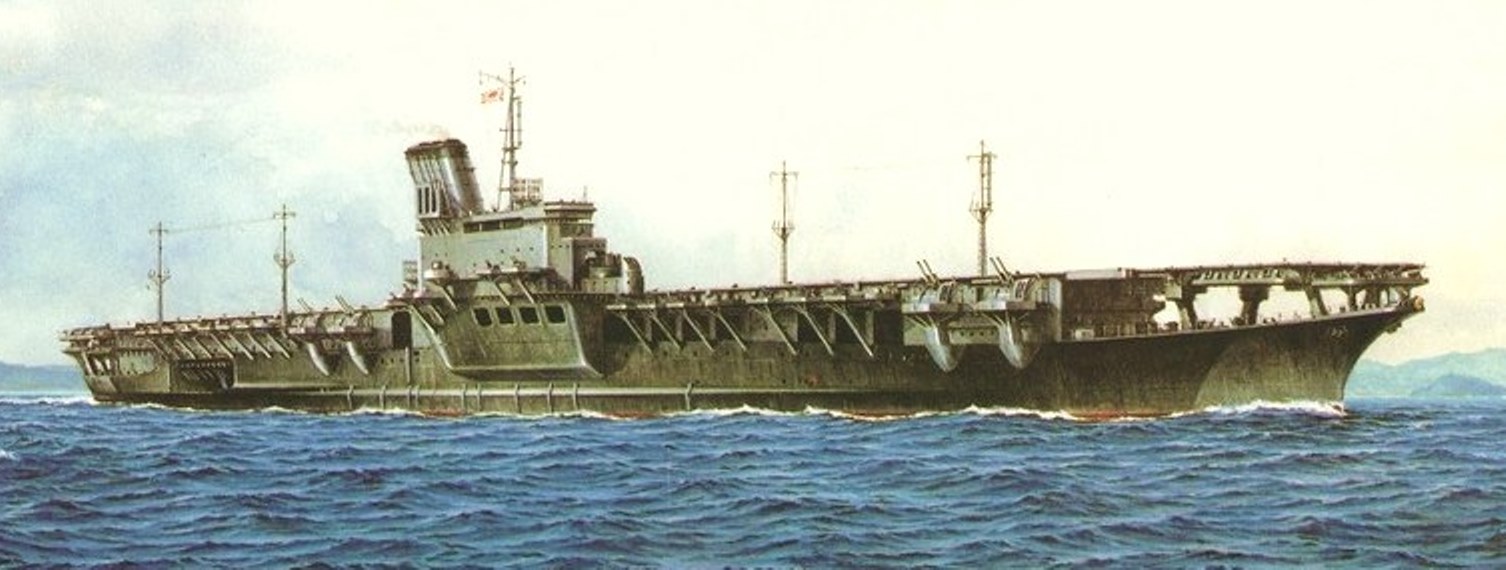
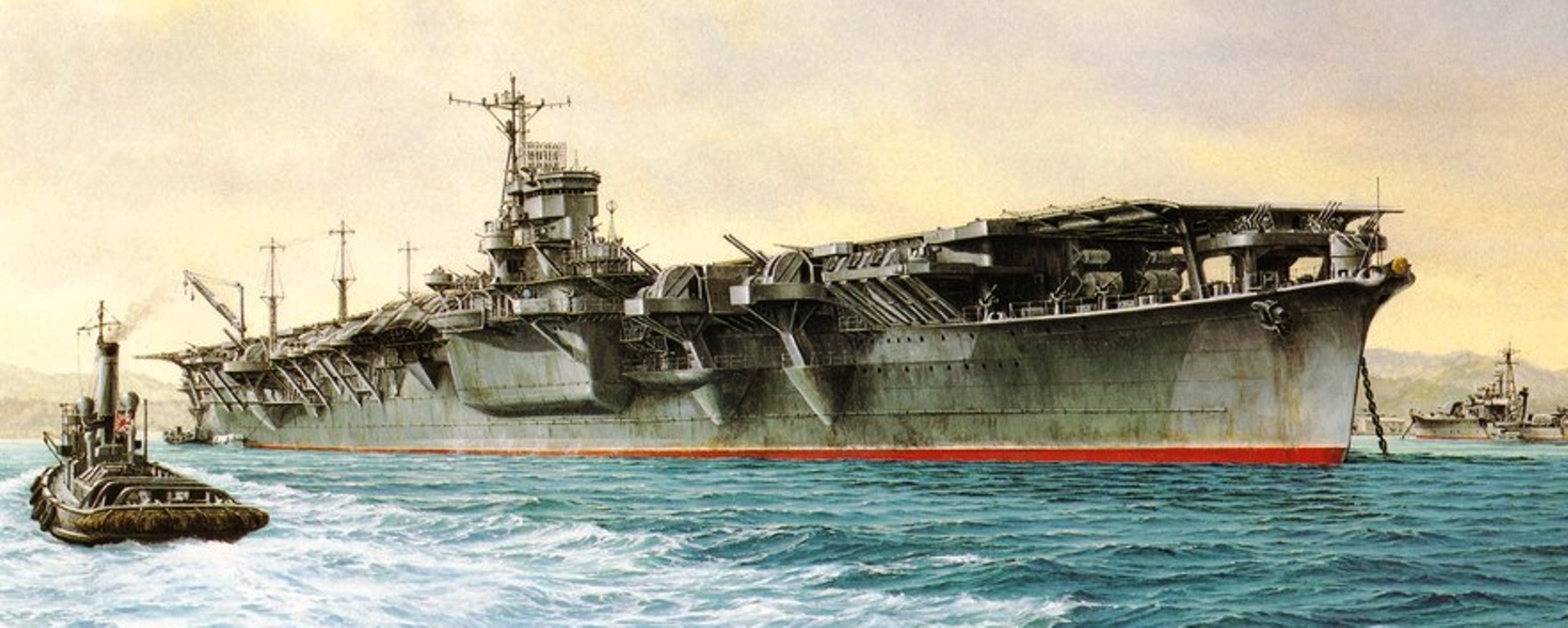 IJN SHINANO and IJN UNRYU
29 November 1944:
IJN SHINANO and IJN UNRYU
29 November 1944:
198 degrees 108 miles from Omae Zaki lighthouse.
At 0310, SHINANO is hit by four torpedoes fired by Cdr Joseph F. Enright's (USNA
'33) USS ARCHERFISH (SS-311) in her starboard side, but she is able to
maintain speed and course. Soon thereafter, incomplete fittings allow
progressive flooding. SHINANO takes on a heavy list to starboard. Captain Abe
orders the three outboard port boiler rooms flooded to take off some of the
list.
30 November 1944:
By dawn, SHINANO has steamed 36 miles from where
she was torpedoed and is making 11 knots, when her boiler feed water fails. At
0745, SHINANO goes dead in the water. At 0850, HAMAKAZE and ISOKAZE take her in
tow and start to move toward Cape Ushio at 3 knots to beach her. However, the
strain grows too great and the tow has to be abandoned. The list to starboard
resumes and increases. At 1018, Captain Abe orders Abandon Ship. YUKIKAZE comes
alongside to starboard to remove the crew.
At 1055, SHINANO rolls over to starboard bottom up, then sinks by the
stern at 33-07N, 137-04E, taking down, 1,435 officers including Captain Abe and
men, the 50 "Ohka" and 6 "Shinyo" suicide boats. 55 officers, 993 petty officers
and men, plus 32 civilians (total 1,080 survivors (including 3 "Ohka" pilots) are
rescued. HAMAKAZE also recovers the Imperial Portrait from the sea.
The CinC, Combined Fleet, Admiral Toyoda Soemu arrives at Konoike airfield to
inspect the 721st NAG. That same day 30 "Ohka" missiles are transferred to Kure to
be transported to Clark Field, Luzon, via Takao, Taiwan.
13 December 1944:
Captain (Rear Admiral, posthumously) Konishi
Kaname's (44) fleet carrier UNRYU is ordered to load 30 "Ohka" missiles
of the Thunder-Gods Corps for transport to Manila.
17 December 1944:
At 0830, UNRYU departs Kure for Manila, Philippines
escorted by destroyer SHIGURE and DesDiv 52's HINOKI, and MOMI.
19 December 1944:
At 1635, Cdr (later Rear Admiral-Ret) Louis D.
McGregor's (USNA '30) USS REDFISH (SS-395) fires four bow torpedoes at UNRYU.
One hits under the bridge. She loses power and goes dead in the water. At 1650,
while damage control parties extinguish fires and engineers restore power in
No. 8 boiler, the carrier is hit by a second torpedo under her forward elevator.
starboard side. Avgas storage explodes and ignites her volatile cargo. At 1657,
UNRYU sinks. Captain Konishi and 1,244 officers and men are KIA. Only one
officer and 146 men are rescued by destroyer SHIGURE.
31 December 1944:
Moji. Captain Matsuura Yoshi's (49) light carrier
RYUHO departs Moji, accompanying the convoy HI-87 on the first part of its route
via Formosa to Hong Kong and Singapore, carrying 58 "Ohkas". The convoy also
consists of fleet oiler KAMOI and tankers KAIHO, KUROSHIO, HASHIDATE, MATSUSHIMA,
MITSUSHIMA, MIRI, MUNAKATA, TENEI and SARAWAK MARUs and the passenger-cargo ship
TATSUWA MARU, escorted by destroyers HATAKAZE, SHIGURE, YUKIKAZE and DesDiv17's
HAMAKAZE and ISOKAZE, plus kaibokans MIKURA, YASHIRO, KURAHASHI and CD-13.
YUKIKAZE soon suffers a burst steam pipe and has to return to the Inland Sea.
7 January 1945:
Approaching Kirun (Keelung), Formosa, the convoy
undergoes attack by a submarine a wolf pack consisting of USS BARB (SS-220) and
USS PICUDA (SS-382), later joined by USS QUEENFISH (SS-393). At 0905, in heavy
seas, USS PICUDA torpedoes and heavily damages tanker MUNAKATA MARU's bow. She
proceeds separately to Kirun. At 1300, RYUHO and SHIGURE are also detached to
Kirun.

 IJN RYUHO and IJN SHIGURE"
20 January 1945:
IJN RYUHO and IJN SHIGURE"
20 January 1945:
The first G4M2e "Betty" bombers of the 721st NAG
arrive at Kanoya airfield, Kyushu. On that same day a 24-strong "Ohka" Fighter
Squadron, led by Lt(jg) Hosokawa Hachiro is activated at the 721st NAG to
conduct kamikaze attacks with Mitsubishi A6M5 fighters carrying 500-kg bombs.
25 January 1945:
The transfer to Kanoya airfield is completed.
8 March 1945:
Kanoya Naval Air Base, Kagoshima Prefecture,Kyushu,
Japan. A USAF Boeing B-29 "Superfortress" overflies the airfield and takes
the first intelligence photos of the new "Ohka". The Americans nickname them
"Viper".
17 March 1945:
The "Ohka" rocket-assisted glide bomb is officially
adopted into service.
18 March 1945:
K708 is transferred to Usa airfield, northeastern
Kyushu, to conduct the first "Ohka" strike against Task Force 58. After 1000,
before the squadron can take off, the airfield is attacked by VF-9 and VF-10
carrier fighters from USS YORKTOWN (CV-10) and INTREPID (CV-11). Most bombers
and missiles of the K708 are destroyed on the ground. The S306 and S307 fighter
squadrons from Tomitaka airfield likewise suffer heavy losses when trying to
intercept the intruders. Both fighter units are transferred to Kasanohara
airfield thereafter.
21 March 1945: The First "Ohka" Attack:
Kanoya. Vice Admiral Ugaki
Matome, CinC, 5th Air Fleet, orders his 203rd Naval Air Group to launch the
first "Kikusui" (Floating Chrysanthemum) operational sortie employing "Ohkas".
At 1100, two Nakajima C6N1 "Myrt" long-range reconnaissance aircraft take off
to locate and shadow an American Task Group, first sighted 360 miles SSE of
Kanoya. Starting at 1120, a total of eighteen G4M2e bombers take off from
Kanoya to attack Rear Admiral (later Admiral-Ret) Joseph J. Clark's (USNA '17)
TG 58.1 consisting of fleet carriers HORNET (CV-12), BENNINGTON (CV-20) and
WASP (CV-18) and light carrier BELLEAU WOOD (CVL-24), escorted by battleships
USS INDIANA (BB-58) and USS MASSACHUSETTS (BB-59) and a strong force of cruisers
and destroyers.
Fifteen of the "Betty" bombers (the 1st and the 2nd flights of the K711
squadron led by LtCdr Nonaka Goro) are carrying the "Ohka" missiles. Close
escort is provided by thirty-two Kanoya-based A6M5 "Zeros" from the 721st NAG
fighter units (S306 and S307), led by Lt Urushiyama Mutsuo (70). One fighter
crashes immediately after take-off and twelve return to Kanoya with mechanical
problems. Top cover is provided by twenty-three A6M5 "Zeros" from the 203rd
NAG in Kasanohara, led by LtCdr Okajima Kiyokuma (63).
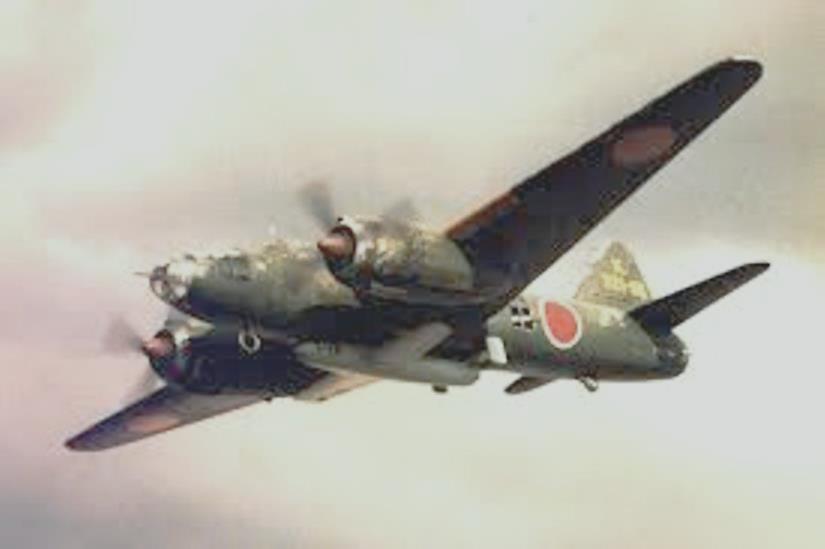
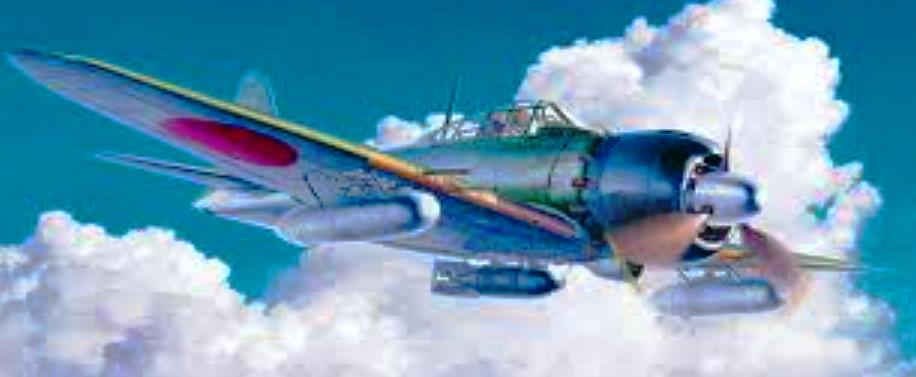 G4M2e "Betty" bomber carrying an "Ohka" Type 11 and
an A6M5 "Zeke"
80 miles NW of Task Group 58.1. Around 1400, radar on light carrier USS
LANGLEY (CVL-27) picks up the incoming attack 85 miles NW of the TG 58.1.
Immediately, more fighter aircraft are launched to augment the existing Combat
Air Patrol (CAP) bringing the USN interceptor force to more than 150 Grumman
F6F "Hellcat" fighters and Chance-Vought F4U "Corsairs". The VF-17 CAP division
from USS HORNET, led by Lt James L. Pearce, and the VBF-17 "Corsair" division
from the same carrier, led by Lt(jg) Henry E. Mitchell, Jr., are ordered to
intercept the intruders. They are joined by two Grumman F6F-5 "Hellcat"
divisions from the BELLEAU WOOD, led by LtCdr Douglas A. Clark.
At 1415, LtCdr Nonaka orders his strike to stand by to attack.The G4M2e
bombers approach at 13,000 ft, flying in a "V of Vs" formation. Their close
escort is staggered at 14,000 ft and the top cover at 16,000 ft.
60 miles N of the carriers, VBF-17 from USS HORNET (CV-12) with 8 F6F-5
"Hellcats" engages the top cover, while VF-17 attacks the bombers. One VF-30
"Hellcat" division engages the IJNAF close escort while the second chases the
bombers. The bombers dive to sea level in an attempt to retire northward,
dropping chaff; some jettison their missiles as well. Within 20 minutes all 18
"Bettys" are shot down. The "Hellcats" and "Corsairs" make quick work of most
"Zekes" and their inexperienced young pilots. The 721st NAG loses ten "Zeros"
(including the one flown by Urushiyama) and the 203rd NAG two fighters,
force-landing after receiving combat damage. Although some attackers manage to
close to within 30 miles from the carriers, not a single "Ohka" is launched at
them. A total of 137 bomber crews and 15 "Ohka" pilots are lost.
CTG 58.1 reports a total of 26 "Bettys", 12 "Zeros" and 2 Mitsubishi J2M
"Jacks" shot down, with another "Betty", 2 "Zeros" and a Kawasaki Ki-61 "Tony"
damaged in the melee. [1][2]
1 April 1945: American Operation "Iceberg" – The Invasion of Okinawa:
G4M2e "Betty" bomber carrying an "Ohka" Type 11 and
an A6M5 "Zeke"
80 miles NW of Task Group 58.1. Around 1400, radar on light carrier USS
LANGLEY (CVL-27) picks up the incoming attack 85 miles NW of the TG 58.1.
Immediately, more fighter aircraft are launched to augment the existing Combat
Air Patrol (CAP) bringing the USN interceptor force to more than 150 Grumman
F6F "Hellcat" fighters and Chance-Vought F4U "Corsairs". The VF-17 CAP division
from USS HORNET, led by Lt James L. Pearce, and the VBF-17 "Corsair" division
from the same carrier, led by Lt(jg) Henry E. Mitchell, Jr., are ordered to
intercept the intruders. They are joined by two Grumman F6F-5 "Hellcat"
divisions from the BELLEAU WOOD, led by LtCdr Douglas A. Clark.
At 1415, LtCdr Nonaka orders his strike to stand by to attack.The G4M2e
bombers approach at 13,000 ft, flying in a "V of Vs" formation. Their close
escort is staggered at 14,000 ft and the top cover at 16,000 ft.
60 miles N of the carriers, VBF-17 from USS HORNET (CV-12) with 8 F6F-5
"Hellcats" engages the top cover, while VF-17 attacks the bombers. One VF-30
"Hellcat" division engages the IJNAF close escort while the second chases the
bombers. The bombers dive to sea level in an attempt to retire northward,
dropping chaff; some jettison their missiles as well. Within 20 minutes all 18
"Bettys" are shot down. The "Hellcats" and "Corsairs" make quick work of most
"Zekes" and their inexperienced young pilots. The 721st NAG loses ten "Zeros"
(including the one flown by Urushiyama) and the 203rd NAG two fighters,
force-landing after receiving combat damage. Although some attackers manage to
close to within 30 miles from the carriers, not a single "Ohka" is launched at
them. A total of 137 bomber crews and 15 "Ohka" pilots are lost.
CTG 58.1 reports a total of 26 "Bettys", 12 "Zeros" and 2 Mitsubishi J2M
"Jacks" shot down, with another "Betty", 2 "Zeros" and a Kawasaki Ki-61 "Tony"
damaged in the melee. [1][2]
1 April 1945: American Operation "Iceberg" – The Invasion of Okinawa:
Vice Admiral (later Admiral) Raymond A. Spruance's (USNA '06) Fifth Fleet,
including more than 40 aircraft carriers, 18 battleships, 200 destroyers and
over 1,000 support ships surround Okinawa. Lt Gen (Gen, posthumously) Simon B.
Buckner Jr's Tenth Army (7th, 77th, 96th Infantry, 2nd, 6th Marine divisions)
makes amphibious landings and begins the campaign to take the island from the
Imperial Army's LtGen Ushijima Mitsuru's 32nd Army defenders.
On Yontan airfield, Okinawa, 15 "Ohkas" are captured by the United
States Marines. Since the discovery is made on April Fool's Day, they are
nicknamed "Baka", Japanese for fool.
The Second "Ohka" Attack:
That same day, after 0221 six
"Ohka"-carrying G4M2e bombers of the 1st and the 2nd flights of K708 take off
from Kanoya for a dawn attack against TF 54 battleships sighted off the Okinawa
main island. Around 0245, the lead bomber, piloted by Lt(jg) Sawamoto Yoshio, is
intercepted and crippled by an American nightfighter. After dropping its
unmanned missile, the "Betty" ditches off Cape Sata at the southern tip of the
Osumi Peninsula, Kyushu. The "Ohka" pilot, FPO Yamamura Keisuke and three
bomber crewmembers are rescued the following morning.
One bomber crashes against a mountain in the southern part of Osumi
Peninsula. One bomber loses its bearings in bad weather, jettisons its missile
and returns to Usa. One bomber manages to land in Taiwan, but crashes during the
return flight. Two other bombers, one from each flight, vanish without a trace.
A total of 14 bomber crews and 3 "Ohka" pilots are lost.

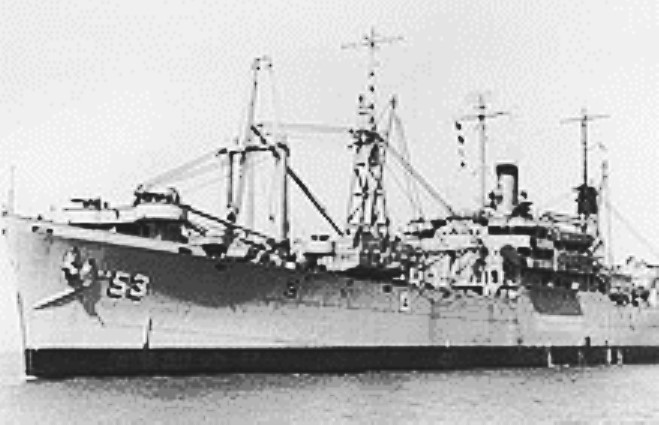 USS ALPINE (APA-92) and USS ACHERNAR (AKA-53)
USS ALPINE (APA-92) and USS ACHERNAR (AKA-53)
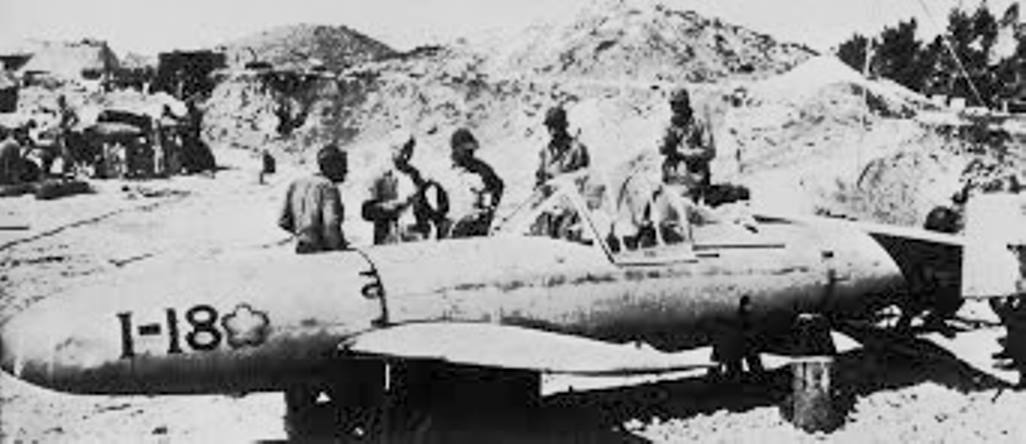
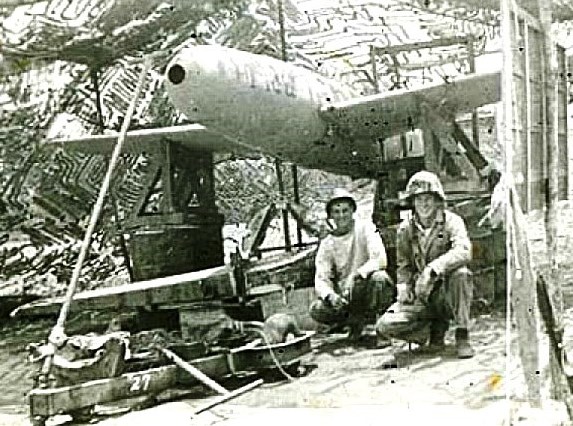 "Ohka" rocket glide bombs captured on Okinawa
12 April 1945: The Third "Ohka" Attack.
"Ohka" rocket glide bombs captured on Okinawa
12 April 1945: The Third "Ohka" Attack.
Between 1130 and 1234 eight
"Ohka"-carrying G4M2e "Betty" bombers from K708 (1-3 flights) take off from
Kanoya; only two return. 35 bomber crews and 8 "Ohka" pilots are killed.
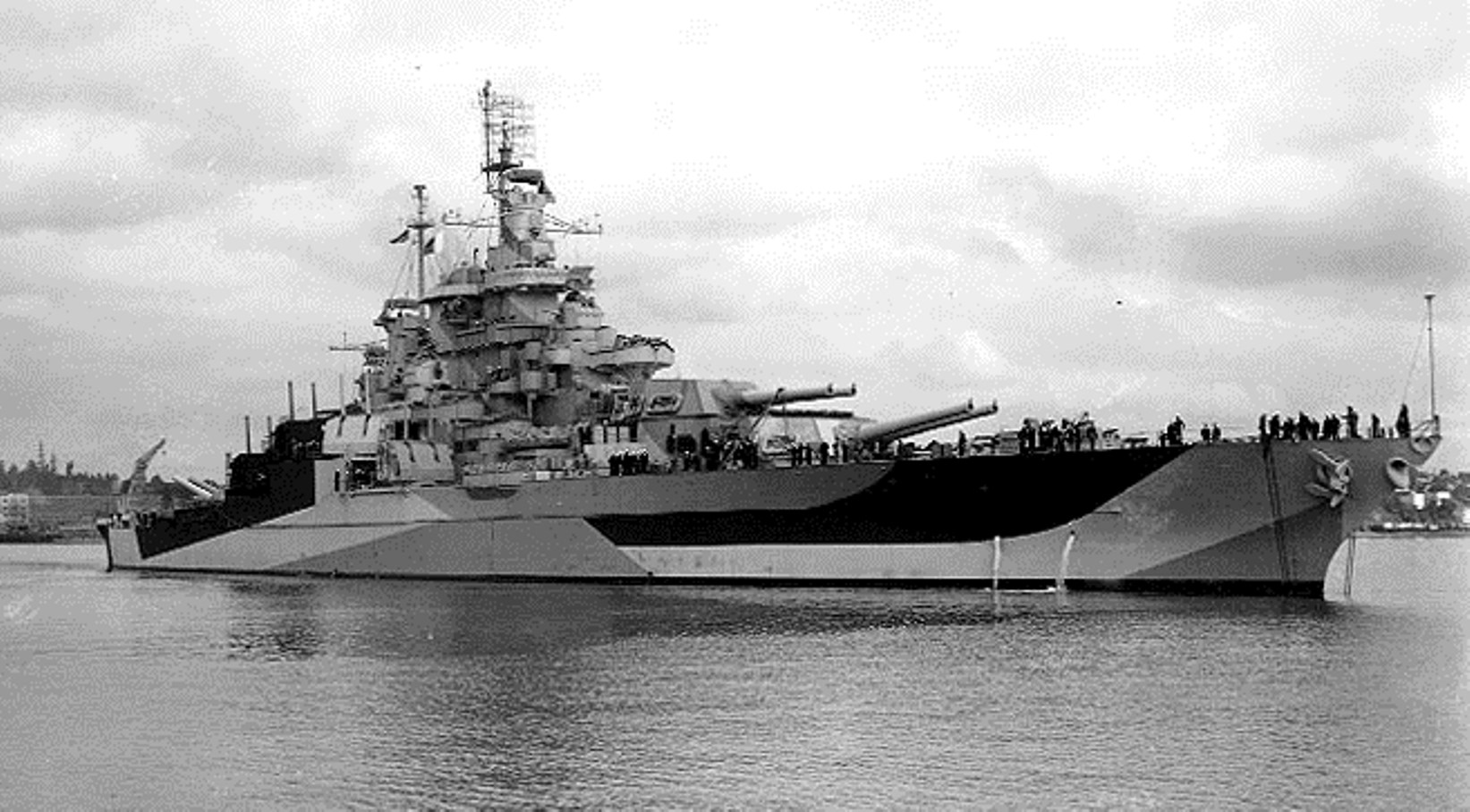
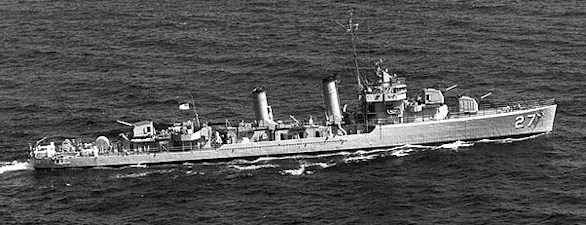 USS WEST VIRGINIA (BB-48) and USS JEFFERS (DMS-27)
80 miles NW of Okinawa. At 1440, nine G4M2e bombers and a number of A6M
"Zeke" kamikazes attack Radar Picket Station No. 14, consisting of LtCdr A.
E. Parker's destroyer MANNERT L. ABELE (DD-733), Landing Ship Medium (Rocket)
(LSM(R)-189 and (LSM(R)-190. At 1446, USS ABELE is attacked from different
angles by three A6Ms. One hits USS ABELE in the aft engine room starboard. Its
bomb explodes and fractures the destroyer's propeller shaft and breaking her
back. At 1441, an Ohka also hits ABELE and explodes. USS MANNERT L. ABELE
breaks in two and at 1444 sinks. 79 crewman are KIA and 35 are wounded. Lt(jg)
Dohi Saburo, launched by Ensign Miura Kitaro's bomber from the 3rd flight, is
credited with the hit.
NW of Okinawa. At 1435, destroyer-minesweeper USS JEFFERS (DMS-27) of
Radar Picket Station No. 12 is attacked by a GM42e, misidentified as Nakajima
Ki-49 "Helen" at a range of of 14,000 yds and an altitude of 4,000 ft, that
releases an "Ohka". The AA gunners knock down the "Ohka" just 50 yds from the
ship, but its explosion causes extensive damage forcing JEFFERS to withdraw.
Lt James M. Stewart's LSMR-189 and LSMR-190 pick up survivors while
engaging and shooting down two A6Ms that are strafing men in the water. A third
"Zeke" crashes into LSMR-190 and wounds four crewmen.
N of Okinawa. At midday, destroyer USS CASSIN YOUNG (DD-793) of Radar
Picket Station No. 1 is attacked by a wave of kamikaze. The destroyer's accurate
AA gunfire aids in shooting down five aircraft, but a sixth crashes high-up in
her foremast, exploding only 50 feet from the ship. One crewman is KIA and 58
are wounded, many seriously.
USS WEST VIRGINIA (BB-48) and USS JEFFERS (DMS-27)
80 miles NW of Okinawa. At 1440, nine G4M2e bombers and a number of A6M
"Zeke" kamikazes attack Radar Picket Station No. 14, consisting of LtCdr A.
E. Parker's destroyer MANNERT L. ABELE (DD-733), Landing Ship Medium (Rocket)
(LSM(R)-189 and (LSM(R)-190. At 1446, USS ABELE is attacked from different
angles by three A6Ms. One hits USS ABELE in the aft engine room starboard. Its
bomb explodes and fractures the destroyer's propeller shaft and breaking her
back. At 1441, an Ohka also hits ABELE and explodes. USS MANNERT L. ABELE
breaks in two and at 1444 sinks. 79 crewman are KIA and 35 are wounded. Lt(jg)
Dohi Saburo, launched by Ensign Miura Kitaro's bomber from the 3rd flight, is
credited with the hit.
NW of Okinawa. At 1435, destroyer-minesweeper USS JEFFERS (DMS-27) of
Radar Picket Station No. 12 is attacked by a GM42e, misidentified as Nakajima
Ki-49 "Helen" at a range of of 14,000 yds and an altitude of 4,000 ft, that
releases an "Ohka". The AA gunners knock down the "Ohka" just 50 yds from the
ship, but its explosion causes extensive damage forcing JEFFERS to withdraw.
Lt James M. Stewart's LSMR-189 and LSMR-190 pick up survivors while
engaging and shooting down two A6Ms that are strafing men in the water. A third
"Zeke" crashes into LSMR-190 and wounds four crewmen.
N of Okinawa. At midday, destroyer USS CASSIN YOUNG (DD-793) of Radar
Picket Station No. 1 is attacked by a wave of kamikaze. The destroyer's accurate
AA gunfire aids in shooting down five aircraft, but a sixth crashes high-up in
her foremast, exploding only 50 feet from the ship. One crewman is KIA and 58
are wounded, many seriously.
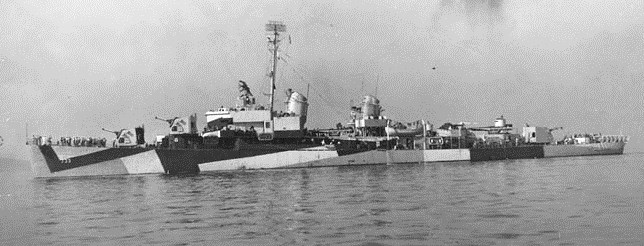
 USS MANNERT L. ABELE (DD-733) and USS CASSIN YOUNG
(DD-793)
Destroyers USS STANLY (DD-478) and LtCdr John T. Bland's USS LANG
(DD-399) at Radar Picket Station No. 2 (NE of Okinawa main island) are ordered
to Radar Picket Station No. 1 to assist CASSIN YOUNG, but soon the two
destroyers come under kamikaze attack. USS STANLY's fighter-director team
takes charge of YOUNG's combat air patrol (CAP). Under USS STANLY's direction,
the CAP fighters shoot down six Aichi D3A "Val" naval dive bombers in rapid
succession.
USS MANNERT L. ABELE (DD-733) and USS CASSIN YOUNG
(DD-793)
Destroyers USS STANLY (DD-478) and LtCdr John T. Bland's USS LANG
(DD-399) at Radar Picket Station No. 2 (NE of Okinawa main island) are ordered
to Radar Picket Station No. 1 to assist CASSIN YOUNG, but soon the two
destroyers come under kamikaze attack. USS STANLY's fighter-director team
takes charge of YOUNG's combat air patrol (CAP). Under USS STANLY's direction,
the CAP fighters shoot down six Aichi D3A "Val" naval dive bombers in rapid
succession.

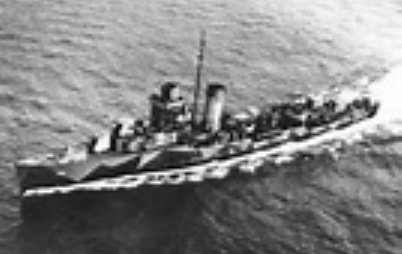 USS STANLY (DD-478) and USS LANG
(DD-399)
USS STANLY is ordered to close the transports anchored off the Hagushi
beaches. En route, a "Zeke" bombs her, but its bomb falls short and the
kamikaze itself misses the destroyer and crashes into the sea. USS STANLY's
casualties, for all the day's action are three wounded sailors. Late that
night, she enters Kerama Retto for repairs. USS CASSIN YOUNG also makes Kerama
Retto under her own power for repairs.
14 April 1945: The Fourth "Ohka" Attack.
USS STANLY (DD-478) and USS LANG
(DD-399)
USS STANLY is ordered to close the transports anchored off the Hagushi
beaches. En route, a "Zeke" bombs her, but its bomb falls short and the
kamikaze itself misses the destroyer and crashes into the sea. USS STANLY's
casualties, for all the day's action are three wounded sailors. Late that
night, she enters Kerama Retto for repairs. USS CASSIN YOUNG also makes Kerama
Retto under her own power for repairs.
14 April 1945: The Fourth "Ohka" Attack.
Between 1130 and 1153, seven
"Ohka"-carrying G4M2e "Betty" bombers from K708 take off from Kanoya to attack a
task force sighted 85 miles E of Tokunoshima. Lt Sawayanagi Hikoshi (71), the
strike leader, transmits a signal announcing that he had launched his missile.
All attackers are lost. A total of 48 bomber crews and 7 "Ohka" pilots are
killed in the attack.
W of Kikaigashima. Around 1300 Lt(jg) Charles E. Watts of VF-17 from USS
HORNET, escorting the photo aircraft with his F6F-5 "Hellcat" division, spots an
unescorted "Betty" bomber carrying an "Ohka" at 11,000 ft. Diving down, Watts
opens fire and hits the starboard engine of the bomber. The "Betty" jettisons
its missile in an attempt to escape. After Watts' third attack the target's
starboard wing collapses and the bomber spirals into the sea. A short time later
the same VF-17 section encounters another "Betty" and shoots it down.
NE of Okinawa main island. At 1410, USS HUDSON (DD-475), patrolling at
Radar Picket Station No. 3 with LCS(L)s 38, 111, and 118, picks up incoming
bogeys 20 miles to the northwest. A division of F6F-5 "Hellcats" from USS
BELLEAU WOOD's VF-30, patrolling over Picket Station No. 3, is vectored to
intercept them. The "Hellcats", led by Ens James J. Noel, sight two incoming
"Betty" bombers at 8,000 ft and another at 4,000 ft. They are escorted by a
single "Zero" at 19,000 ft. Ens H. A. Lee attacks the "Zero". After
receiving multiple hits to the engine, its pilot bails out. Ens Noel damages
the starboard wing and engine of one of the higher-flying "Bettys". It soon
explodes, the wing breaks off and the bomber spirals toward the ocean. Ens
Keith W. Curry catches up with the second "Betty", hitting its wing root and
fuselage. Before going down, one of the bombers jettisons its missile which
hits the water without making any attempt to fly.
The third "Betty", under attack by Ens R. L. Rhodes and flying at 4,000
ft, plummets into the sea after being hit in both engines.
16 April 1945: The Fifth "Ohka" Attack.
Between 0605 and 0708, six
"Ohka"-carrying G4M2e "Betty" bombers from K708 (the 1st and the 2nd flights)
take off from Kanoya to attack shipping off Okinawa. Only two bombers return,
one of them still carrying its missile. Lt(jg) Sawai Masao, leading the 1st
flight, reports a successful launch, after which a pillar of smoke was sighted
rising from that direction.
8 miles NW of Iheya Shima Island. Near Radar Picket Station No. 1, two
F6F-5 "Hellcats" from USS SAN JACINTO (CVL-30) and two F4U Corsairs from
another unit intercept an "Ohka"-carrying G4M2e "Betty", targeting the already
crippled USS LAFFEY (DD-724). The bomber releases its missile, but its engine
fails and the "Ohka" spirals aimlessly into the water. Its carrier receives
multiple hits and is finally downed by Lt(jg) L. Grossman from VF-45.
NW of Okinawa main island. Over Radar Picket Station No. 14, another
"Ohka"-carrying bomber, misidentified as a Nakajima Ki-49 "Helen" is
intrercepted by two VMF-323 F4U "Corsairs" from Kadena, Okinawa. Flying at 8000
ft, the G4M2e takes violent evasive action and jettisons its missile, but is
then downed by 2/Lt (later Colonel) Dewey F. Durnford, Jr.
28 April 1945: The Sixth "Ohka" Attack.
Kanoya Naval Air Base, Japan.
After 1625, four "Ohka"-carrying G4M2e bombers from K708 take off for an
evening attack against the Allied shipping off Okinawa. Two bombers return, one
still carrying its missile. Only one bomber reaches the target area and, after
sighting AA fire in the dark, launches his "Ohka", piloted by FPO1C Yamagiwa
Naohiko at 1935. A column of fire is sighted. Off Amakusa Island the returning
"Betty" is intercepted by the US fighters and ditches as a result of combat
damage. Two other bombers likewise ditch at sea off the west coast of Kyushu.

 G4M2e "Betty" bomber releasing an "Ohka" and an "Ohka"
under rocket propulsion diving on an Allied warship.
4 May 1945: The Seventh "Ohka" Attack:
G4M2e "Betty" bomber releasing an "Ohka" and an "Ohka"
under rocket propulsion diving on an Allied warship.
4 May 1945: The Seventh "Ohka" Attack:
After 0522, seven
"Ohka"-carrying G4M2e bombers from K708 and K711 take off from Kanoya to
attack targets off Okinawa. Only two return, one carrying its missile. A total
of 35 bomber crews and 6 "Ohka" pilots are killed in the attack.
They are posthumously credited with sinking one battleship and one cruiser.
Five bombers attack the US fleet 20 miles NE of Zampa Misaki, Okinawa.
Destroyer-minelayer USS SHEA (DM-30) is on radar picket duty when at 0854 a
single "Betty" is sighted six miles distant and shot down by CAP, directed from
SHEA, just four minuts later. At 0859, a lookout spots an incoming "Ohka" on
starboard beam, closing fast. The missile, piloted by Lt(jg) Ohashi Susumu,
crashes into SHEA's bridge area, entering the sonar room, traversing the chart
house, passageway and explodes beyond the port side on the water. Fire breaks
out on the mess deck, the CIC, the chart house, division commander's stateroom,
No. 2 upper handling room, and compartment A-304-L.
USS SHEA loses all ship's communications, 5-inch gun mounts Nos. 1 and 2
are inoperative and the forward port 20-mm guns are damaged. The main director is
jammed and the gyro and computer are rendered unserviceable. One officer and 34
men are KIA, and 91 others wounded. Listing 5 degrees to port, SHEA limps off to
Okinawa and medical assistance. She arrives at 1052 and her most seriously
wounded are transferred to USS CRESCENT CITY (APA-21) and the 35 dead are
removed for burial on Okinawa. USS SHEA then limps to Kerama Retto anchorage for
repairs.
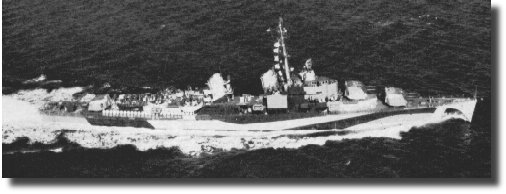
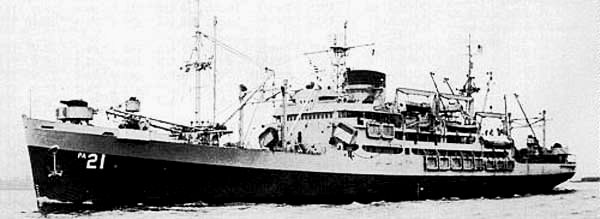 USS SHEA (DM-30) and USS USS CRESCENT CITY (APA-21)
WNW of Okinawa main island. Patrolling at Radar Picket Station No. 12,
minelayer HENRY A. WILEY (DM-12) is targeted by two "Ohka"-carrying G4M2e
"Betty" bombers. The first "Ohka", closing from the starboard quarter, receives
several hits, strikes the water, bounces over WILEY's fantail and explodes just
off the port quarter. Another "Ohka" heading for WILEY is caused to divert by
the AA fire and misses her by 1200 yds.
After 0947 minelayer USS GAYETY (AM-239), tasked with sweeping mines off
Okinawa Tori Shima, is also attacked by an "Ohka" that makes a low altitude run
at an estimated speed of 350-400 knots, initially targeting the smaller
minesweeper YMS-331, and then turning toward GAYETY. The ship's gunners AA fire
hits the "Ohka" and it disintegrates very rapidly, tumbling end-over-end into
the sea 15 yds off GAYETY's port bow. Plywood an aluminium debris knocks out the
starboard 40-mm gun and wounds three men, but the ship continues her duties.
The mother plane, identified as Mitsubishi Ki-46 "Dinah", is shot down by two
Grumman FM-2 "Wildcats" of VC-90 from USS STEAMER BAY (CVE-87), piloted by Lt
Freal J. Gibson and Lt(jg) D. S. Paulsen.
5 May 1945:
USS SHEA (DM-30) and USS USS CRESCENT CITY (APA-21)
WNW of Okinawa main island. Patrolling at Radar Picket Station No. 12,
minelayer HENRY A. WILEY (DM-12) is targeted by two "Ohka"-carrying G4M2e
"Betty" bombers. The first "Ohka", closing from the starboard quarter, receives
several hits, strikes the water, bounces over WILEY's fantail and explodes just
off the port quarter. Another "Ohka" heading for WILEY is caused to divert by
the AA fire and misses her by 1200 yds.
After 0947 minelayer USS GAYETY (AM-239), tasked with sweeping mines off
Okinawa Tori Shima, is also attacked by an "Ohka" that makes a low altitude run
at an estimated speed of 350-400 knots, initially targeting the smaller
minesweeper YMS-331, and then turning toward GAYETY. The ship's gunners AA fire
hits the "Ohka" and it disintegrates very rapidly, tumbling end-over-end into
the sea 15 yds off GAYETY's port bow. Plywood an aluminium debris knocks out the
starboard 40-mm gun and wounds three men, but the ship continues her duties.
The mother plane, identified as Mitsubishi Ki-46 "Dinah", is shot down by two
Grumman FM-2 "Wildcats" of VC-90 from USS STEAMER BAY (CVE-87), piloted by Lt
Freal J. Gibson and Lt(jg) D. S. Paulsen.
5 May 1945:
Following the heavy losses, the K711 bomber squadron is
disbanded.
11 May 1945: The Eighth "Ohka" Attack:
After 0556 four "Ohka"-carrying
G4M2e bombers from K708 (the 1st and the 2nd flights) take off from Kanoya for a
strike against the Allied shipping off Okinawa. One returns with its missile and
is heavily damaged during the landing. Three other bombers with a total of 21
crews and 3 "Ohka" pilots are lost.[3]
At 0855, above Radar Picket Station No. 15, four VMF-221 F4U-1D "Corsairs"
from USS BUNKER HILL, led by Captain James E. Swett, shoot down an "Ohka"-carrying
"Betty". The bomber begins to burn at the wingroot and spins in. As it hits the
water, the "Ohka" explodes. 1/Lt Ralph O. Glendinning is credited with the kill.
N of Okinawa. Four F6F-5 "Hellcats" from USS BATAAN's (CVL-29) VF-47 shoot
down another "Ohka"-carrying "Betty".
40 miles NW of the Okinawa Transport Area. Kamikaze aircraft of the
"Kikusui" Raid No. 6 attack Cdr Baron J. Mullaney's destroyer USS HUGH W. HADLEY
(DD-774) and Cdr Robert J. Archer's USS EVANS (DD-552) on Radar Picket Station
No. 15 with three landing ships. USS HADLEY is acting as fighter-director
control for F4U "Corsairs" of the CAP from USS SHANGRI-LA (CV-38) and VMF-323.
From 0750 to 0930, the "Corsairs" destroy three G4M bombers and a large number
of an estimated 156 Japanese aircraft attacking the American ships.
USS HADLEY's AA gunners destroy twenty enemy planes, but at 0920, while
manoeuvering at high speed, she is hit aft by a bomb and a kamikaze, followed by
a hit by an "Ohka". The destroyer suffers extensive damage and flooding. 28
crewmen are KIA and 67 wounded. Cdr Mullaney orders Abandon Ship, but leaves a
skeleton crew to fight the raging fires aboard.
During the morning attacks, destroyer USS EVANS is hit by four kamikaze
that flood her aft engineering spaces. Without power, her crew uses portable
fire extinguishers and bucket brigades to save her. After the attacks cease,
the landing craft move in to assist. Thirty-two crewmen are KIA and 27 wounded.
EVANS is credited with 19 aircraft (including the planes that struck her) plus
four more shared with USS HADLEY. Together, the two destroyers account for a
record 42 enemy aircraft. Both ships are awarded the Presidential Unit Citation
for this action.

 USS GAYETY (AM-239) and USS HUGH W. HADLEY
(DD-774)
25 May 1945: The Ninth "Ohka" Attack:
USS GAYETY (AM-239) and USS HUGH W. HADLEY
(DD-774)
25 May 1945: The Ninth "Ohka" Attack:
After 0500 eleven
"Ohka"-carrying G4M2e bombers from K708 take off from Kanoya for a dawn attack
against Allied shipping off Okinawa. Admiral Toyoda Soemu is present to bid the
pilots farewell. Eight bombers encounter a heavy rain squall and return to
base without locating their targets. Three disappear without a trace.
NW of Okinawa main island, near Picket Station No. 16A. At 0845,
destroyers USS COWELL (DD-547), INGERSOLL (DD-652) and WREN (DD-568) shoot down
an attacking "Betty" bomber that crashes about 100 yds from WREN.
22 June 1945: The Tenth "Ohka" Attack:
After 0525, six G4M2e
bombers take off from Kanoya for the 721st NAG's final combat sortie. Lt(jg) Ito
Shoichi (73) leads the strike against the Allied shipping S of Okinawa. Eight
bomb-carrying A6M5 "Zeros" from No. 1 "Jinrai" Unit also participate. Over
Kasanohara airfield the 721st NAG's strike rendezvouses with 66 escort
fighters, but 25 of these soon turn back with mechanical problems.
Approaching Okinawa from the northwest in a loose formation, the strike
is soon detected by radar pickets and intercepted. NW of Okinawa main island.
Near radar picket station No. 15A, an F4U-1D "Corsair" of the VMF-224 piloted by
2/Lt Harry L. Triece shoots down a "Betty" that releases its missile before
going down. Near radar picket station No. 16, another "Betty", carrying an
"Ohka", is shot down by F4U-1D "Corsairs" of VMF-314 from Ie Shima. Two
bombers return without launching their missiles.
A total of 28 bomber airmen and 4 "Ohka" pilots are lost. [4]
23 August 1945:
Komatsu airfield, Honshu. To prevent unauthorized
attacks on the Allied fleet, the 721st NAG is disbanded. The airworthy bombers
are dispersed to different airfields and their crews are ordered to return home.
Author's Notes:
This Special Feature is intended to cover only operational
missions by "Ohka" Type 11s at Okinawa. About 852 "Ohkas" were built of which
755 were Type 11s; other types included 21, 22, 33, 43A (Ko), 43B (Otsu), 53,
K-1 and 43 K-1 Kai Wakazakura. Many other kamikaze aircraft were also employed
against the Fifth Fleet, but these operations are beyond the scope of this page.
Although the numbers vary according to their sources, during World War II
despite radar detection, airborne interception and anti-aircraft barrages, about
2,800 kamikaze planes of all types sank at least 34 Navy ships, damaged 368
others, killed 4,900 sailors and wounded over 4,800. At least 14 percent of
kamikazes scored a hit on a ship and nearly 8.5 percent of all ships hit sank.
[1] Lt(jg) Henry E. Mitchell of VBF-17 was credited with 5 "Bettys",
making him an ace in a day.
Lt(jg) Murray Winfield of VF-17 was credited
with 4.5 "Bettys" (one shared with an F4U pilot).
Ens James V. Ward and
W. H. Smith, Jr., both of VF-30, were credited with 3 "Bettys" each.
Ens
James V. Reber of VF-30 was credited with 2 "Bettys" and 2 "Zeros."
Lt James
L. Pearce of VF-17 was credited with 2 "Bettys".
Lt(jg) Harvey W. Sturdevant
of VF-30 was credited with one "Betty" and 2 "Zeros."
LtCdr Douglas A. Clark
of VF-30 was credited with one "Zero" and damaging another.
[2] Although some sources identify battleship USS WEST VIRGINIA (BB-48)
as an "Ohka" target on 1 April, this is not confirmed by wartime action records.
Her attacker was identified as a Nakajima Ki-43 "Oscar", carrying a 551-lb bomb.
The attack transport USS ALPINE (APA-92), likewise credited with being
hit by an "Ohka" on that day was attacked by a single-engined fighter. Attack
cargo ship ACHERNAR (AKA-53), another ship reportedly damaged by an "Ohka" on
2 April was in reality hit by an IJA kamikaze aircraft from Tokunoshima.
[3] Early in the morning two "Ohka"-carrying G4M2e bombers from
K708 had taken off from Kanoya in an attempt to crater the runways of Yontan
airfield on Okinawa with their missiles. One of the bombers developed engine
trouble en route and returned while the other encountered heavy cloud cover,
likewise aborting the attack. Although undertaken by the 721st NAG, this
sortie is not considered an "Ohka" attack as such.
[4] Between 18 March and 22 June 1945, the US forces reported encounters
with a total of 57 "Ohkas". 42 of their mother planes were shot down before
they could launch their glider bombs. Four "Ohkas" managed to hit their targets,
sinking one ship.
Special thanks go to Sander Kingsepp of Estonia for info in Rev 1.
-Bob Hackett
Back to the IJNAF
Page



























